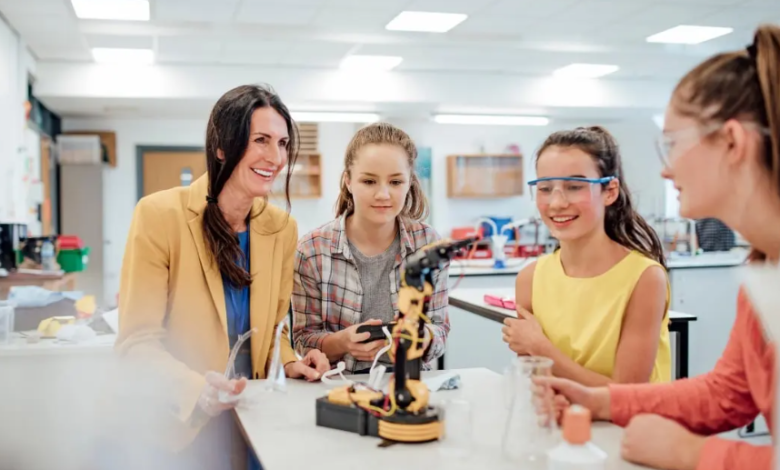Building Engaging Learning Environments with EdTech Software

For educators and institutions, engagement isn’t a bonus; it’s a necessity. Disengaged learners struggle to retain knowledge and lose motivation quickly. Today’s students expect dynamic, flexible, and tech-driven experiences that go beyond static classrooms.
EdTech learning software plays a vital role in transforming lessons into immersive experiences. It combines personalization, gamification, and analytics to keep learners active participants rather than passive observers.
In 2025, these expectations continue to evolve. Students now look for interactive, accessible, and human-centered digital environments that reflect how they learn and connect in the real world.
This blog explores how innovative tools and design principles make engagement measurable, scalable, and sustainable across modern education systems.
1. Personalization Through AI and Adaptive Learning
AI is redefining the learning experience by customizing lessons in real time. Intelligent algorithms analyze behavior, quiz responses, and time spent on modules to adapt the content accordingly.
Adaptive learning pathways ensure that students remain challenged without feeling overwhelmed. They progress at their own pace, which boosts confidence and improves retention.
Examples of personalization in practice include:
- Language apps are adjusting exercises based on accuracy rates
- Math platforms are increasing in complexity after consistent performance
- Career simulators aligning content with professional skill levels
Personalization builds a sense of ownership in learning. When students see lessons evolve based on their performance, they stay motivated to complete courses and pursue new goals.
2. Data-Driven Insights for Continuous Improvement
Every click, quiz attempt, or pause in a video generates valuable data. Modern platforms use these metrics to refine teaching methods and identify where learners need help.
Dashboards present real-time insights into engagement, participation, and comprehension. Teachers can quickly adjust content or offer targeted feedback before learners fall behind.
Dynamic content updates based on data make learning more responsive and relevant. Over time, these insights shape smarter lesson planning and support long-term academic success.
3. Gamification and Interactive Content
Gamification is more than entertainment—it’s a proven way to improve focus and retention. Gamified learning solutions report an annual growth rate of 28.58%, showing how education increasingly borrows from game design.
Incorporating points, badges, and leaderboards helps learners visualize progress and celebrate small wins. Simulations, quizzes, and interactive storytelling make concepts tangible and reduce learning fatigue.
Benefits of gamified learning include:
- Encourages healthy competition
- Reinforces knowledge through repetition
- Improves motivation and attention span
Gamification aligns learning with natural reward systems, keeping students eager to return and improve their scores.
See also: Top Car Window Tint for Heat Reduction and Comfort in Hot Areas
4. Immersive Learning via VR and AR
Virtual and augmented reality bring lessons to life. Instead of reading about an event or process, learners experience it firsthand.
Examples of VR and AR applications in education:
| Use Case | Learning Impact |
| Virtual Labs | Safe, hands-on experimentation |
| AR Science Models | Deeper conceptual understanding |
| Skill Simulations | Real-world application and readiness |
These tools are especially effective in technical, medical, and creative subjects where physical limitations often restrict practice. Immersive learning allows students to explore without fear of mistakes while building confidence through repetition.
5. Collaboration and Social Learning Tools
Learning is social at its core. Digital platforms that promote collaboration replicate classroom interaction in online spaces. Students can brainstorm ideas, share documents, and exchange feedback in real time.
Group projects and peer-to-peer discussions create accountability and community. When learners feel connected, engagement rises, and dropout rates fall.
Ways EdTech enhances collaboration:
- Shared editing tools for group work
- Peer review systems promoting a feedback culture
- Discussion forums that encourage diverse viewpoints
Collaborative platforms bridge the gap between distance and connection, ensuring education remains human and interactive.
6. Teacher and Learner Communication Platforms
Clear communication is critical to engagement. Chat tools, video conferencing, and instant announcements allow teachers to stay available beyond traditional hours.
Real-time communication helps address confusion quickly. Learners receive immediate guidance, while educators can track participation and sentiment across classes.
These systems also enhance emotional support, helping educators maintain a human touch even in large virtual cohorts.
7. Accessibility and Inclusivity Features
Inclusive design ensures that no learner is left behind. By considering various learning styles and physical abilities, platforms make education universally available.
Key accessibility features include:
- Screen reader compatibility
- Captioned video lectures
- Adjustable text sizes and color contrasts
- Multi-language support
- Mobile and offline access
Universal design principles also benefit non-disabled users. For example, captioned videos help multilingual learners, and offline access supports those in low-connectivity regions. Inclusive education ensures engagement is possible for everyone, regardless of circumstance.
8. Offline and Low-Bandwidth Learning Options
Not every learner has stable internet access. Platforms that allow offline use or asynchronous participation extend learning to remote areas.
Students can download lessons, complete quizzes, and sync their work later. This flexibility empowers working adults, traveling students, and rural learners to continue their education without disruption.
Offline support also ensures that engagement metrics reflect genuine participation rather than connectivity privilege.
9. Assessments and Feedback for Active Learning
Active learning happens when students engage critically with material. Interactive assessments like scenario-based quizzes, drag-and-drop modules, or virtual debates encourage critical thinking over memorization.
Instant feedback loops enhance this process. Learners can see mistakes, correct them, and understand concepts faster. Educators gain insight into comprehension trends and can personalize remediation before final evaluations.
Advantages of interactive assessments:
- Promotes self-reflection
- Strengthens critical thinking
- Provides immediate reinforcement of concepts
Feedback-driven learning encourages students to take responsibility for their progress.
10. Continuous Feedback Loops Between Learners and Instructors
Ongoing feedback ensures continuous engagement. Modern systems support weekly progress reports, automated analytics summaries, and open dialogue between instructors and students.
This two-way exchange keeps learners informed and instructors responsive. It replaces rigid grading systems with dynamic, growth-focused evaluations.
Feedback loops also help educators measure emotional engagement—an often-overlooked factor in retention and success.
Conclusion
Sustained engagement depends on both technology and empathy. Tools may evolve, but the essence of learning remains human.
Modern EdTech learning software empowers educators to personalize, connect, and adapt at scale. With the right design principles, institutions can turn digital classrooms into environments that inspire curiosity and creativity.
As technology advances, the future of learning will rely on platforms that combine adaptability, inclusion, and analytics. Schools and organizations that invest in these capabilities will build educational systems that grow stronger with every learner they engage.





